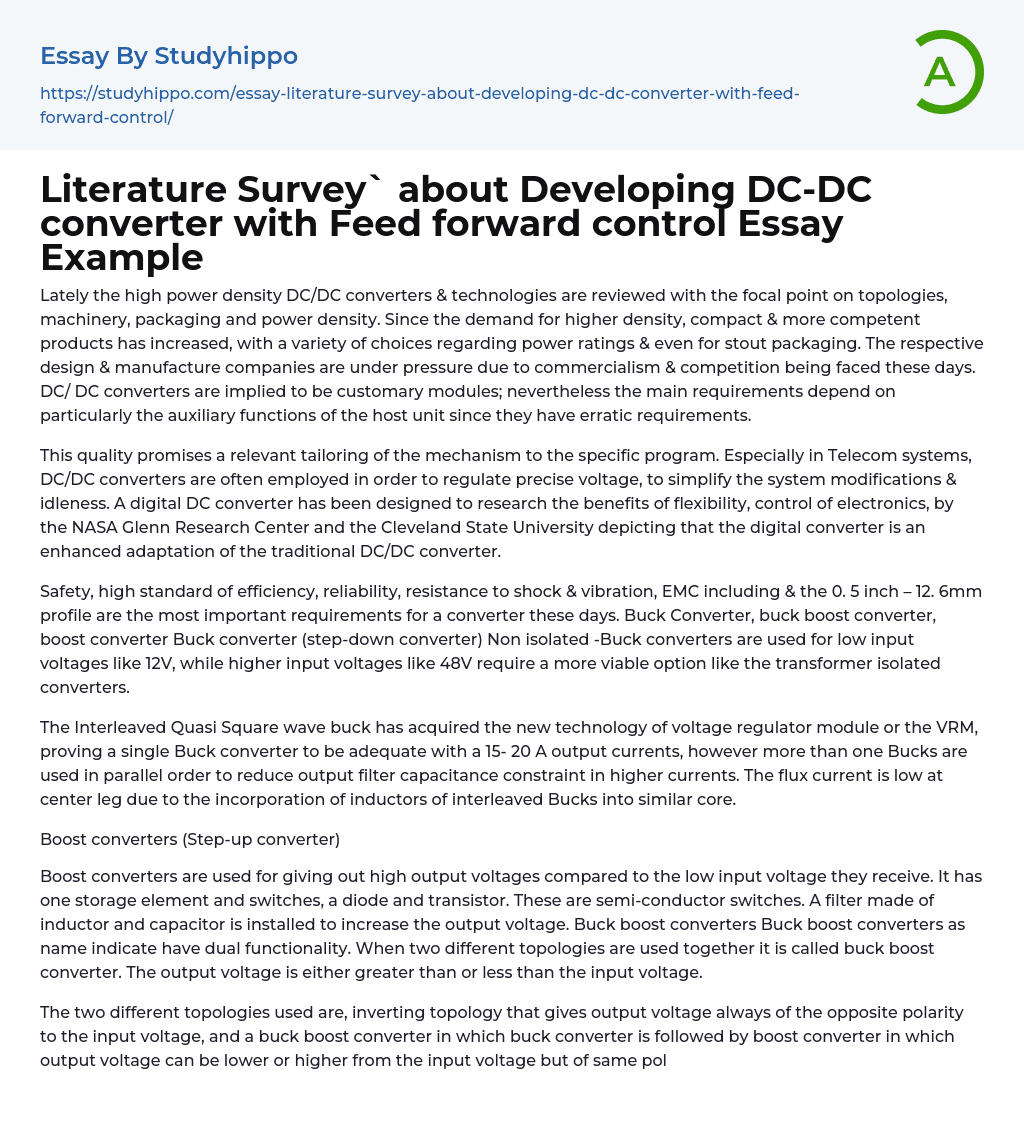

Literature Survey` about Developing DC-DC converter with Feed forward control Essay Example
There has been a recent increase in the examination of high power density DC/DC converters and technologies, with attention on different areas including topologies, machinery, packaging, and power density. The need for smaller and more efficient products with greater density has greatly increased, resulting in a wide array of choices for power ratings and packaging. Design and manufacturing companies are encountering significant difficulties due to commercial pressure and competition within the industry. While DC/DC converters are frequently utilized modules, their specific needs differ depending on the auxiliary functions of the host unit, making them unpredictable.
This feature ensures that the mechanism is tailored accurately to suit the particular program. In Telecom systems, DC/DC converters are commonly used to regulate voltage with precision and facilitate system modifications and downtime. The NASA Glenn Research Center
...and Cleveland State University have developed a digital DC converter to explore the advantages of flexibility and electronic control. This digital converter is an improved version of the traditional DC/DC converter.
In today's world, the main requirements for a converter include safety, high efficiency, reliability, shock and vibration resistance, and EMC compliance with a 0.5 inch – 12.6mm profile. There are different types of converters available to choose from, including the Buck converter, buck boost converter, and boost converter. Buck converters (step-down converters) are suitable for low input voltages like 12V. However, for higher input voltages such as 48V, a more practical solution like transformer isolated converters is necessary.
The Interleaved Quasi Square wave buck now incorporates the new technology of voltage regulator module (VRM), allowing a single Buck converter to handle output currents of 15- 2
A. However, multiple Bucks are used in parallel to minimize the constraint on output filter capacitance at higher currents. The center leg of the core experiences lower flux current due to the inclusion of interleaved Buck inductors.
Boost converters (Step-up converter)
Boost converters are employed to provide higher output voltages than the lower input voltages they receive. They feature a storage element, switches (such as a diode and transistor), and utilize semi-conductor switches. To amplify the output voltage, a filter composed of an inductor and capacitor is implemented. Buck boost converters, as their name suggests, possess a dual functionality, combining two distinct topologies. The output voltage of buck boost converters can be either higher or lower than the input voltage.
The inverting topology and the buck boost converter are both used as topologies. The inverting topology always results in an output voltage that is opposite to the input voltage. On the other hand, the buck boost converter combines a buck converter with a boost converter, allowing for an output voltage that can be higher or lower than the input voltage while maintaining the same polarity.
Having knowledge about digitally controlled dc-dc converters is advantageous for working effectively with a feedforward PWM controller and power switch. These converters provide additional benefits such as digital control of the system and increased flexibility and automation compared to electronic systems.
The Digital DC converter is more advantageous than traditional DC converters because it digitally processes all signals to effectively regulate the voltage of electronic devices. The power switch of the DC DC converter controls the load of the devices, resulting in a change in output
voltage. To manage this, pulse width modulation (PWM) is employed for regulating the output voltage and handling input from the power switch connected to the DC DC converter. PWM functions by utilizing ON and OFF signals. The low pass filter linked with the output switch produces a voltage that corresponds to the ON and OFF states of the PWM.
The excess voltage is returned to the PWM controller, which adjusts and controls the output voltage by regulating the ON times the voltage is returned. Simulation software programs such as P-Spice and Orcad can be employed for effective utilization of the DC-DC converter. These software programs support various converter types, including buck, boost, and buck-boost. They can be used online to perform calculations for the converter and display voltage regulation. Furthermore, these software programs are easily downloadable and compatible with Windows 98, XP, NT4, etc.
- Data collection essays
- Graphic Design essays
- Data Mining essays
- Cryptography essays
- Internet essays
- Network Security essays
- Android essays
- Computer Security essays
- World Wide Web essays
- Website essays
- Computer Network essays
- Application Software essays
- Computer Programming essays
- Computer Software essays
- Benchmark essays
- Information Systems essays
- Email essays
- Hypertext Transfer Protocol essays
- Marshall Mcluhan essays
- Virtual Learning Environment essays
- Web Search essays
- Etiquette essays
- Mainstream essays
- Vodafone essays
- Web Search Engine essays
- Networking essays
- Telecommunication essays
- Network Topology essays
- Telecommunications essays
- Programming Languages essays
- Object-Oriented Programming essays
- Java essays
- Energy Development essays
- The elements essays
- Voltage essays
- Solar Energy essays
- Nuclear Energy essays
- Alternative Energy essays
- Book Summary essays
- Metaphor essays
- Reader essays
- Rhyme essays
- Literary devices essays
- Villain essays
- Books essays
- Genre essays
- Literary Criticism essays
- Writer essays
- Protagonist essays
- Simile essays



